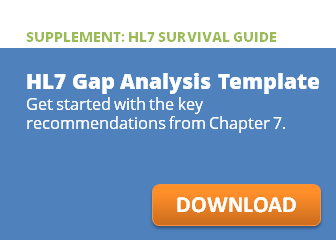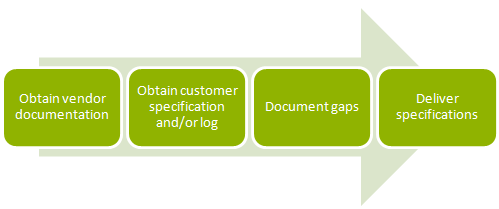 This chapter helps you set up a crucial HL7® requirements document: the gap analysis. Once you have profiles for your source and destination systems, you need to capture a list of all the gaps existing between the two systems in a requirements document. You unearth this list by conducting a gap analysis, which will tell you what’s missing and what needs to be bridged by the interface. In essence, a gap analysis captures the differences in messaging between the new system and the existing IT infrastructure so the systems can exchange data (see the table in Chapter 3 for a list of data and information challenges associated with gaps). A good gap analysis will also document which system and who (you, the vendor, or another third party) will handle any issues.
This chapter helps you set up a crucial HL7® requirements document: the gap analysis. Once you have profiles for your source and destination systems, you need to capture a list of all the gaps existing between the two systems in a requirements document. You unearth this list by conducting a gap analysis, which will tell you what’s missing and what needs to be bridged by the interface. In essence, a gap analysis captures the differences in messaging between the new system and the existing IT infrastructure so the systems can exchange data (see the table in Chapter 3 for a list of data and information challenges associated with gaps). A good gap analysis will also document which system and who (you, the vendor, or another third party) will handle any issues.
How to Develop an Interface Gap Analysis Document
Many analysts develop their own gap analysis templates in Microsoft Word or Excel. To fill in templates, they look at messages, run queries when they can, and manually document their findings. This can be a fairly onerous process if they’re basing the analysis on real-world messages (as opposed to doing a vendor spec walkthrough). Another option is to take advantage of software that automates the gap analysis process.
Whatever your approach, you want answers to the following questions so you can identify gaps related to messages:
1. Does the destination system handle all of the message types from the sending system?
2. Are there any differences between the message structures in each system? If so, what are they?
3. Are there any mandatory data elements on one side that are optional on the other? If so, what are they?
4. Do both systems use the same code sets? Are they the same values? Which values do I need to map?
5. Do both systems specify the same maximum length of characters for data fields?
6. What z-segments are in use?
7. Is the data semantically consistent? In other words, does the meaning or significance of an element always match across both systems?
8. What are the requirements for encryption or de-identification, usage restrictions, and HIPAA compliance related to confidential information?

(Keep reading to download a simple gap analysis template.)
Why You Need This Artifact
No interface matters unless those coding the engine can accurately scope the interfaces they need to build. You need a way to communicate who does what on an interface. Is the vendor changing a field? Is the interface engine handling the field transformation? It’s critical that you pin all this down before interface development begins, or you will be wasting time iterating through multiple changes later in the interface lifecycle.
Business Impact of Missing Gap Analysis
Without a gap analysis that details your requirements, you’ll end up implementing a generic interface that doesn’t address your organization’s unique needs. Your end users will be frustrated that they can’t easily access all the information they need. And you’ll end up wasting time, money, and effort troubleshooting after going live. With a gap analysis, you can avoid extended go-live periods, significant maintenance at increased cost, and unhappy clinician end-users who are unable to access the data they need to deliver appropriate patient care.
Downloadable Gap Analysis Template
The best course of action? Use this sample gap analysis template to get started on the right foot!
[caristixbtn style=”orange” text=”Download Template” url=”https://hl7-offers.caristix.com/hl7-interface-gap-analysis/” blank=”1″]
Your Feedback Welcome
We’ll be publishing chapters from the HL7® Survival Guide over the upcoming weeks and months. See a topic that needs more detail? Have a different perspective on interfacing and interoperability? Tell us in the comments!
Read More in the HL7® Survival Guide
Introduction
Chapter 1: How to Integrate and Exchange Healthcare Data
Chapter 2: Pros and Cons of Interfacing Capabilities
Chapter 3: The Heart of the Matter: Data Formats, Workflows, and Meaning
Chapter 4: How to Work with Vendors and Developing Your EHR Strategy
Chapter 5: Vendors, Consultants, and HL7® Interface Specifications
Chapter 6: Interfacing Artifacts: HL7® Conformance Profiles or Interface Specifications
Chapter 7: Interfacing Artifacts: Gap Analysis
Chapter 8: Interfacing Artifacts: Test Scenarios and Test Systems
Chapter 9: Interfacing Artifacts: Message Samples and Test Messages
Chapter 10: Process and Workflow
Chapter 11: Maintenance, Troubleshooting, and Monitoring
Chapter 12: Definitions
Chapter 13: Contributors and Resources

